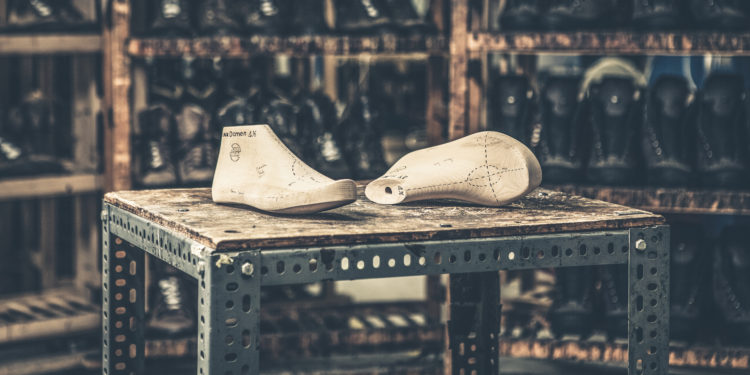Trekking, hiking, mountain shoes – we advise which to choose
Shoes are the basics – if there were a set of basic outdoor truths, this one would surely be at the top of the list. Low, high, all-season, three-season, for summer, with or without a membrane – in this guide we describe the advantages and disadvantages of these solutions, and suggest how to choose the size, how to lace and how to take care of the shoes to make them last as long as possible. Trekking shoes – which one to choose? We answer!
Classification – activity type
Trekking or hiking? A significant difference. It is understood that the latter is a lighter variation of the former, hiking and walking more like a day trip and with a light backpack. They can take place in difficult terrain (scrambling – not yet climbing, but requires support with hands) or at a fast pace (speed hiking). So the basis of differentiation is rather the distance, time and weight of the backpack. Trekking is long hiking, often with camping equipment.
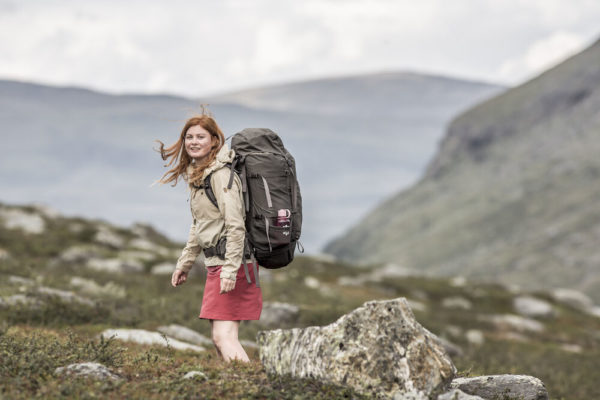
Hiking with such a backpack is trekking (fot. Fjällräven)
Understanding this difference makes it possible to introduce one possible division: into shoes that are light, low, more flexible and often without a membrane (hiking) and those that are more armored, usually high, stiffer and usually with a membrane (trekking).
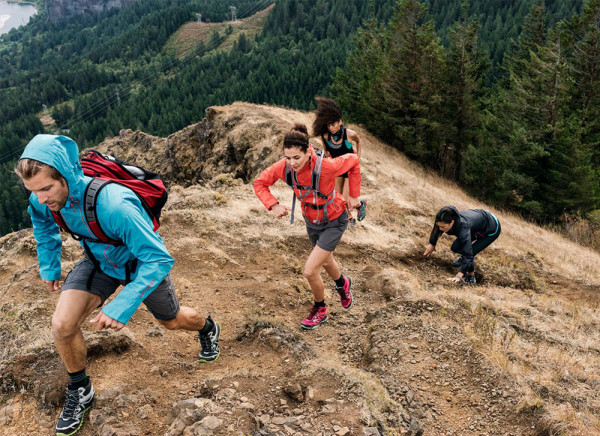
Hiking, or even speed hiking (fot. Merrell)
Classification – seasons / conditions
The division by season is also important. Here, for simplicity, we can also assume two categories, three-season and all-season boots.
Three-season boots are those suitable for trekking or hiking in spring, summer and autumn. Lighter models, made of suede leather, cordura and other synthetic materials, usually with a membrane, will fall into this category. The soles of these boots have moderate stiffness. Although they are ankle boots, their thermal properties are not the highest, so they can be used in winter, but only for short walks in the lowlands and low mountains of the Beskydy type.
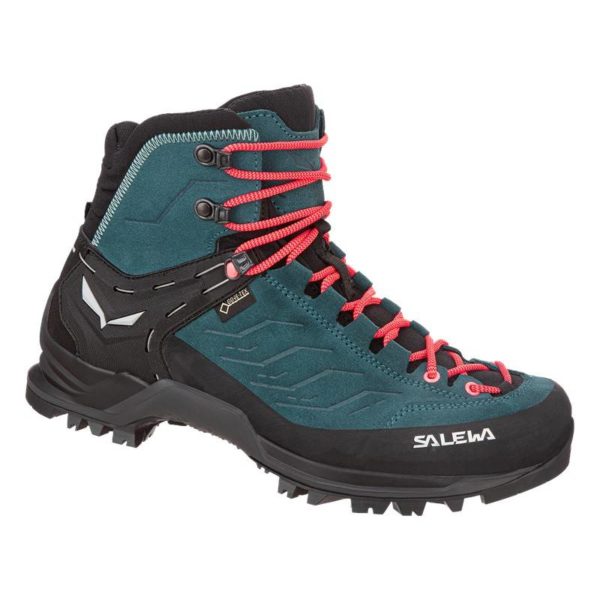
A typical three-season trekking shoe – behind the ankle, with a stiff or moderately stiff sole membrane, nubuck leather upper, two-zone binding, aggressive tread and low rubber lining / Trekking shoes – which to choose (photo. Salewa)
All-season shoes Are usually made of grain or nubuck leather, as well as reinforced synthetic materials. They have much stiffer soles, often thresholds for semi-automatic or automatic crampons, a membrane, an extra layer of insulation and a rubber lining. Without exception, they are high boots. They are referred to as year-round, because we also walk in such shoes in the summer, in high alpine-type mountains, but many people will treat them as typical winter shoes.
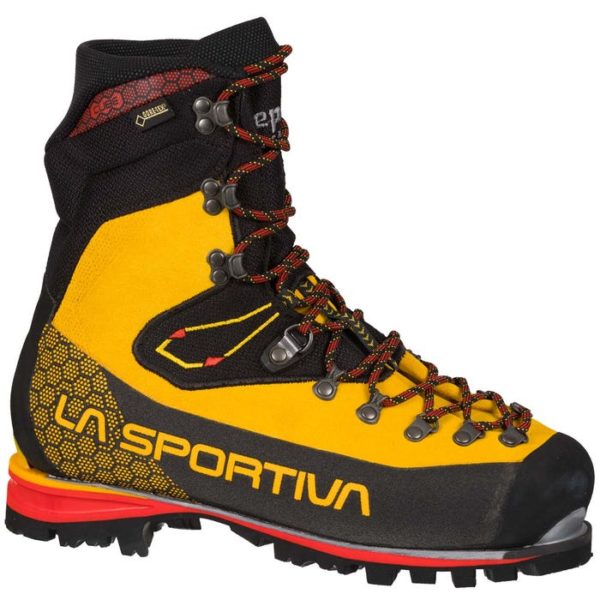 Winter boots, for alpine type mountains and higher. Very stiff sole, compatibility with automatic crampons, high upper finished with a neoprene sock, high rubber lining (fot. La Sportiva)
Winter boots, for alpine type mountains and higher. Very stiff sole, compatibility with automatic crampons, high upper finished with a neoprene sock, high rubber lining (fot. La Sportiva)
Let’s stop for a moment at this classification. If you often hike in summer, in rather low mountains or lowlands, three-season boots (ankle-high and with a membrane) will not be the most comfortable solution. For such conditions, it would be necessary to introduce a third category of typical summer shoes, that is, rather low, without a membrane, light, airy and soft.
High or low boots (approach shoes)
In recent years, there has been a growing number of supporters of shoes with uppers reaching below the ankle, the so-called approach shoes. And no wonder, in such shoes you usually walk very comfortably.
Approaches Will work well mainly when hiking with a light pack and in warm and less humid conditions (light rain ok; downpour, rivers, high wet grasses, snow – not ok). Approach shoes are very good for walking in demanding rocky terrain. Their sole has good grip and is flexible, which is crucial. The stiff sole does not adapt as well to the curves of the rock – it has less contact area. In taller boots, proper footing is also hindered by stiffening at the ankle. Approaches therefore win in rocky terrain, are three-season shoes with an indication of summer and rather hiking.
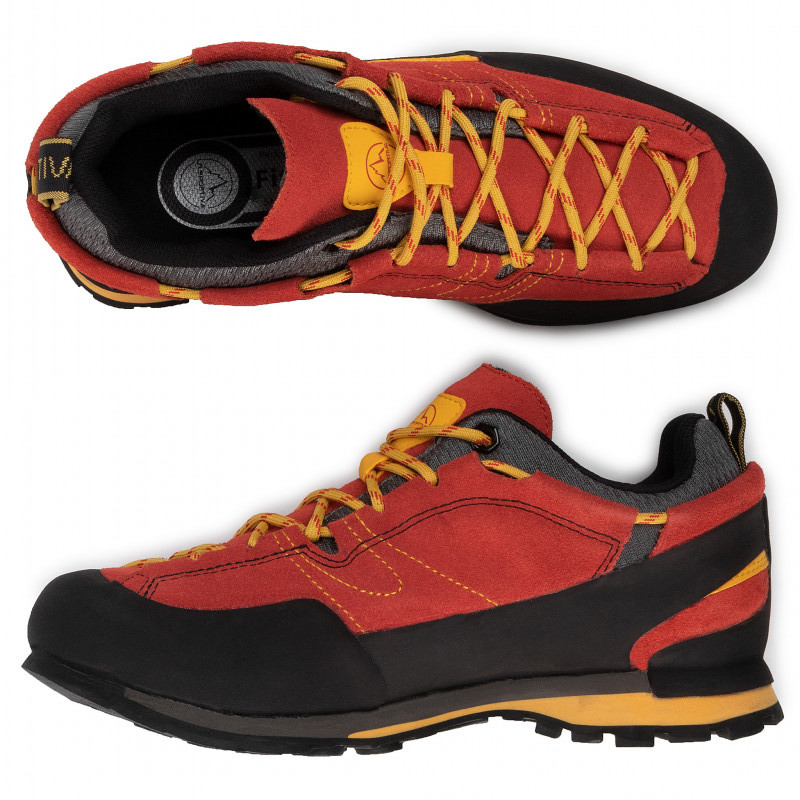
Classic approach / trekking shoes – which to choose (fot. La Sportiva)
For longer trips with a heavy backpack (trekking), on the other hand, the following are recommended ankle boots. Such models will perform better in boggy (moors) or loose (scree) terrain, they will also better protect against flooding with water (crossing a stream) and during solid precipitation (light and moderate rain approaches with a membrane will survive without a problem, but you need to be much more careful about overflowing water from the top). There is less chance of a pebble, mud or snow getting inside through the high upper. High-top shoes better protect against impact, and some believe they also protect against ankle sprains. Here, however, opinions are divided and it will be best to form your own opinion. Such boots are also often chosen by parents, hiking with a carrier.
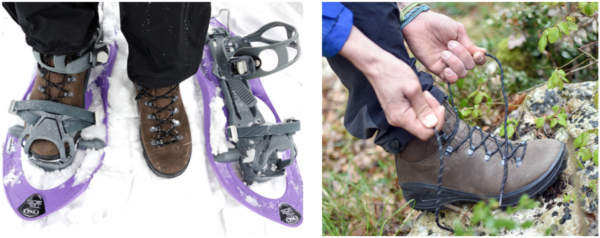
A very traditional model of ankle boots. Uppers and interiors made of grain leather, minimal stitching, no membrane, Vibram brand sole / trekking shoes – which to choose (fot. outdoormagazine.pl)
Approaches are naturally lighter and allow the foot to breathe much better. It is worth noting, however, that in recent years among low hiking boots there has been a thriving category of even lighter, softer and better ventilated (mesh) all-sports shoes, running shoes or those derived from the world of mountain running. Such boots do not provide very good protection against injury, momentarily get wet and are certainly not as durable as, for example, grain leather boots, but for that they are incomparably lighter and very flexible, and therefore comfortable. This is a solution for summer and good weather. Often such boots are used by climbers and skydivers, for whom low weight and small volume after packing are of great importance.
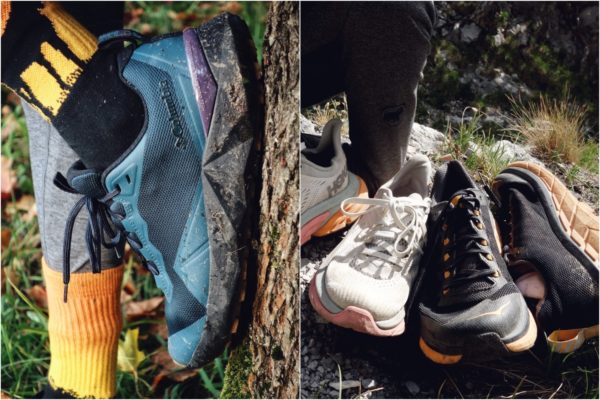
Lightweight shoes with mesh upper, when packed they take up practically as much space as the sole itself. On the left, general sports shoes, on the right, typical running shoes. We took all three pairs on approaches to multi-pitch roads (fot. Outdoor Magazine)
Sole
The sole is mainly characterized by three features: stiffness, grip (type of rubber) and tread.
The stiffest soles are usually found in winter boots with thresholds for crampons automats. Such a shoe almost does not bend, the transfer of weight from foot to foot is facilitated by the cradle-like shape of the sole. High stiffness is indispensable for confidently knocking out steps in hard snow, when climbing in crampons when all the weight must be supported by the front teeth, and when walking in steep snow.
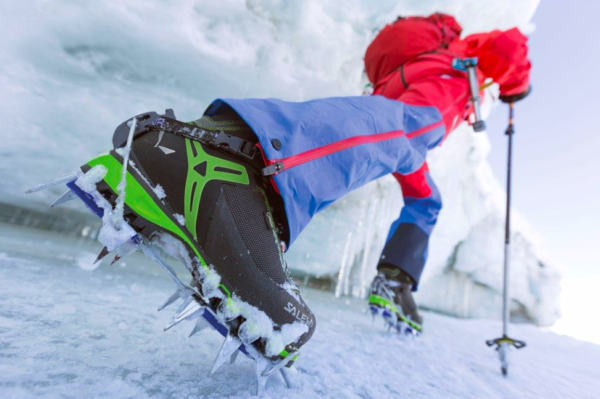
Automatic boots and crampons. Very stiff sole, high synthetic material upper, insulation, membrane (fot. Salewa)
Stiff and moderately stiff soles come in lighter all-season boots and three-season trekking ankle boots. This solution works well in loose terrain (scree) and on small stones and unevenness, when hiking with a heavy backpack we might otherwise feel discomfort underfoot. Such soles bite better into soft soil and mud. Moderately stiff soles are found in most approach shoes.
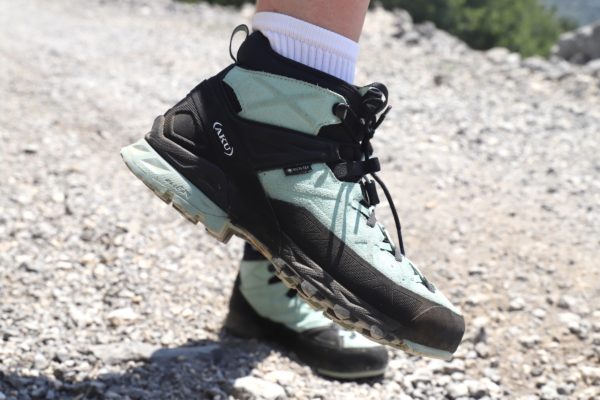 Moderately stiff sole / trekking shoes – which to choose (fot. outdoormagazine.pl)
Moderately stiff sole / trekking shoes – which to choose (fot. outdoormagazine.pl)
Soft soles Usually used in low boots, sometimes high boots, but with a more hiking and summer profile (such hybrids are on the rise lately). They provide greater comfort, better adapt to uneven terrain, give a better “feel” of the ground underfoot, traction on rocky ground, and thus – a sense of confidence. Instead, they behave much worse on mud, wet grass, soft soil, fine and sharp bumps.
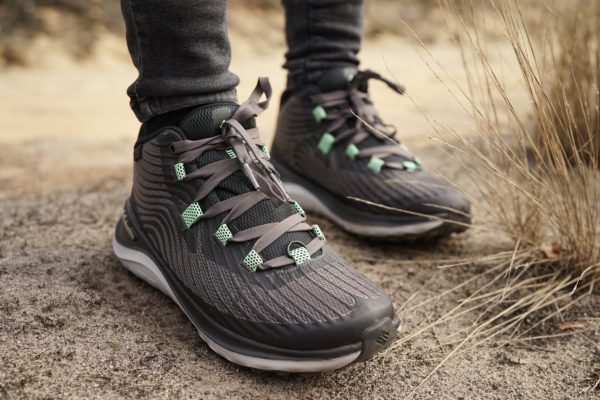 Hybrid for spring/autumn: with a membrane and behind the ankle, but lightweight and with a relatively soft sole (fot. outdoormagazine.pl)
Hybrid for spring/autumn: with a membrane and behind the ankle, but lightweight and with a relatively soft sole (fot. outdoormagazine.pl)
Very soft soles are found in the previously mentioned all-sports type boots. This is usually a thin layer of rubber on EVA foam. You will run more comfortably in such shoes (better cushioning, high midfoot mobility), but they may prove too soft in many mountain situations.
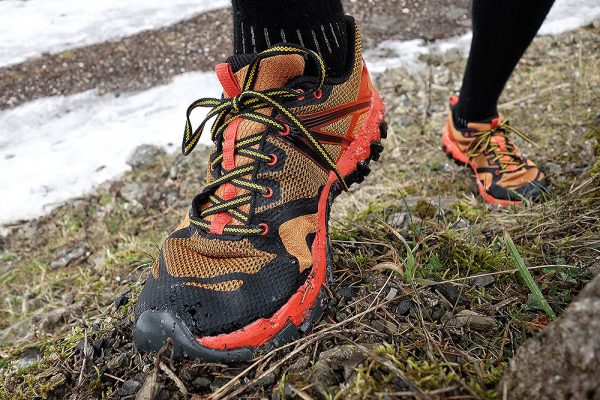 Mesh upper, EVA foam midsole, thin rubber sole with good tread (fot. Outdoor Magazine)
Mesh upper, EVA foam midsole, thin rubber sole with good tread (fot. Outdoor Magazine) 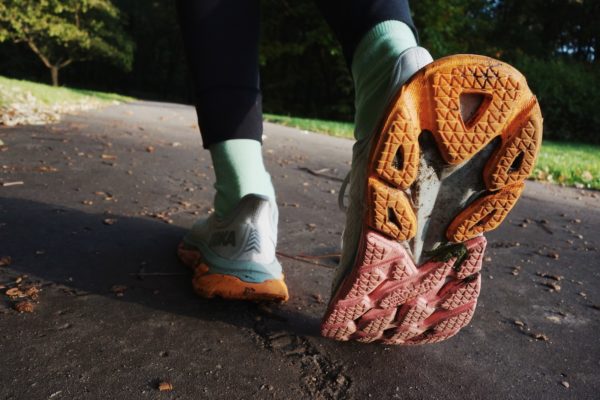 Running shoes with a sole made entirely of EVA foam – ultralight and soft, but not for mountains and wet conditions (fot. outdoormagazine)
Running shoes with a sole made entirely of EVA foam – ultralight and soft, but not for mountains and wet conditions (fot. outdoormagazine)
When it comes to grip soles, among outdoor shoes for years the brand Vibram is the king. You can also trust other blends used by leading manufacturers, such as the Michelin. It is certainly not worth experimenting with rubbers of unknown origin. Traction is also greatly affected by the stiffness and purpose of the shoe model. Trekking boots usually have worse grip for better longevity. Approaches have better grip and slightly worse longevity. Keep in mind that Vibram is not equal to Vibram. And once again: a soft sole stands up better to friction. Hard, stands up better at the tip.
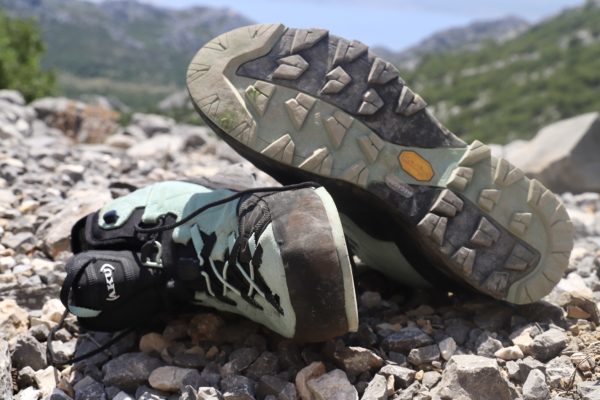 Vibram brand sole in hybrid approaches with ankle upper / trekking shoes – which to choose (fot. outdoormagazine.pl)
Vibram brand sole in hybrid approaches with ankle upper / trekking shoes – which to choose (fot. outdoormagazine.pl)
Tread. Patents such as self-cleaning channels are mostly marketing gimmicks. However, the tread is worth looking at very closely. On soft surfaces, it will be responsible for traction – not the type of rubber. Sharp, aggressive, deep – are assets in soft terrain. Tire-like, shallower, fine – are assets on wet and hard surfaces.
 Tread that bites into the soft ground / trekking shoes – which to choose (fot. Outdoor Magazine)
Tread that bites into the soft ground / trekking shoes – which to choose (fot. Outdoor Magazine)
The patent that works is „climbing zone” in approaches, the smooth part of the sole at the very tip. But also not in all of them, and in rather stiffer models – in soft ones you will not stand well on the tip of the shoe anyway.
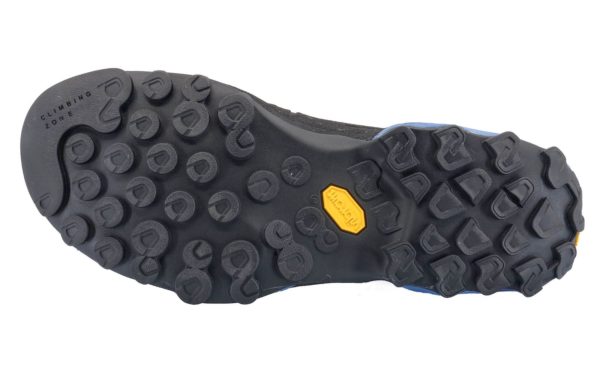 The sole of good approach shoes with a clear „climbing zone” / trekking shoes – which to choose (fot. La Sportiva)
The sole of good approach shoes with a clear „climbing zone” / trekking shoes – which to choose (fot. La Sportiva)
With or without the membrane?
There is no clear answer to this question, and the opinions of users and experts are divided. I have described this problem more extensively here:
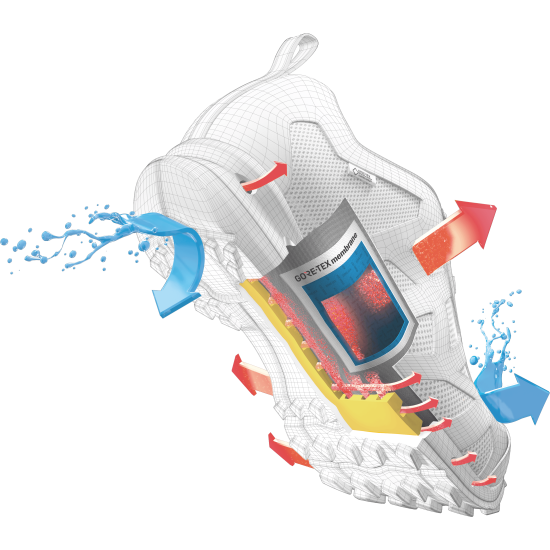 Gore-Tex membrane in Surround technology, that is, with holes in the sole to improve the drainage of water vapor / trekking shoes – which to choose (fot. Gore-Tex)
Gore-Tex membrane in Surround technology, that is, with holes in the sole to improve the drainage of water vapor / trekking shoes – which to choose (fot. Gore-Tex)
Here I will cite only the most important findings:
- The membrane protects against getting wet,
- Moisture wicking to the outside (breathability) is the Achilles heel of membranes,
- any additional barrier negatively affects breathability. In dry and warm conditions it is better to use shoes without a membrane,
- during intense exertion, the membrane “can’t keep up” with moisture removal, then the foot sweats like in a plastic bag,
- The membrane can wick evaporating sweat to the outside of the shoe through diffusion, but under conditions: there must be a difference in humidity and temperature on the two sides of the membrane, the micropores must not be clogged with dirt, the material under which the membrane is lined must not be wet,
- The membrane protects against getting wet, but is relatively fragile and deteriorates faster than other parts of the shoe,
- The membrane makes sense mainly in boots used in winter,
- despite problems with breathability, we often opt for boots with a membrane anyway, because warm sweat is better than cold water.
In warm and dry conditions, it is better to use shoes with mesh, large fabric inserts, no rubber lugs and no membrane. Such shoes are at the same time lighter. In winter, in wet conditions or when there is a danger of sudden changes in the weather (in the Tatra Mountains in summer), it is better to use boots with a membrane, which, even if less breathable, still protect against getting wet. In warmer conditions, a Gore-Tex membrane used with Surround technology (picture earlier), i.e. with holes in the sole of the boot, works really well. Such a sole naturally loses a bit of stiffness – it is worth bearing this in mind.
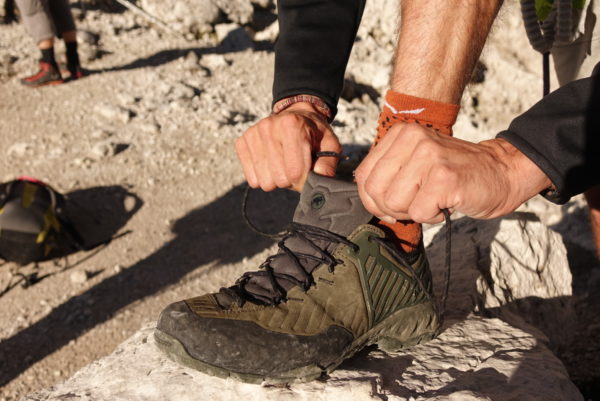 Approaches with a membrane (photo. outdoormagazine.pl)
Approaches with a membrane (photo. outdoormagazine.pl)
On the other hand, the highest level of waterproofing is provided by models with a membrane and an upper made of thick grain leather, which can be cleaned and treated for years.
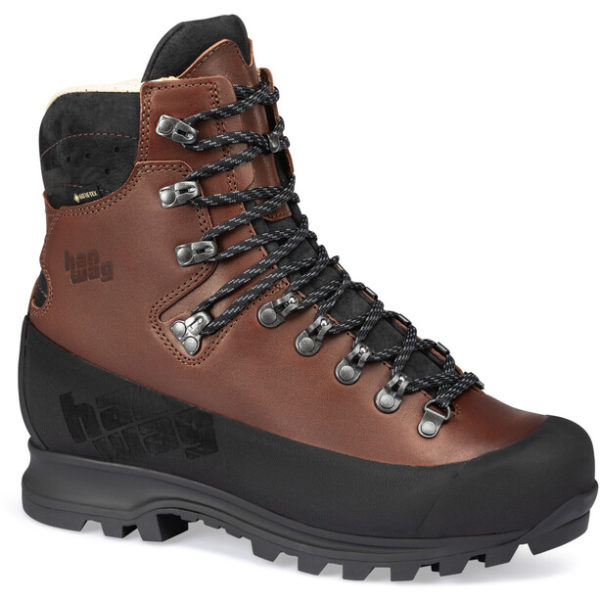 The best protection against soaking: membrane, grain leather, high lag (photo. Hanwag)
The best protection against soaking: membrane, grain leather, high lag (photo. Hanwag)
In alpine-type mountains and higher, boots with synthetic uppers and a membrane are most often used. Such boots are lighter than leather ones, and there is less risk of getting wet in the snow and cold temperatures.
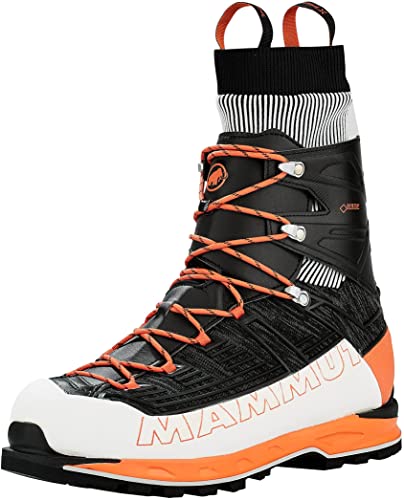
Model designed for mountaineering in winter conditions. A membrane, high ottoman and additional snow protector will protect against getting wet. Weight reduction through the use of synthetic uppers (fot. Mammut)
Before you buy new shoes, ask yourself some important questions
If you like different activities, at different times of the year, there is no chance that you will end up with one pair. At the end of the text I present my set of shoes, and here are some questions to answer for yourself, before buying:
- At what times of the year will I use the shoes?
- In what terrain and what conditions?
- Whether it will be short or long, multi-day hikes?
- How much will the backpack I will be carrying weigh?
- What kind of exercise it will be: quiet and prolonged, or shorter but intense?
- Will I be climbing, climbing via ferrata, running or cycling in them?
Sizing, measuring new shoes, fitting
It is impossible to buy shoes for mountains, running or other activities without trying on several pairs and sizes. We can only take the size we wear every day as a starting point. Numbering of different manufacturers may vary. So let’s measure!
Remember to take into account the slack in the shoe. Feet swelled from long walking, high temperature (in the shoe), staying at high altitude. Do not buy trekking shoes on contact! Here are the proven ones ways to measure shoes:
- Method I. Wear a thicker sock. Remove both insoles and stand on them. There should be about 1 cm of slack at the front of the insole. If the foot ends up level with the insole, the shoe is too small!
- Method II. Dress shoes, move the foot forward so that the toes touch the tip of the shoe. Slide the index finger behind the heel. If we can slip it on relatively loosely, the size is good.
- Method III. If there are stairs in the store, walk on them for a long while – quickly and briskly. Focus on the sensation in the toes, especially when stepping down. The toes must not hit the front wall of the shoe. On the other hand, the heel must not be too loose.
It is worth trying on several models, not everyone will fit our foot. We should feel comfortable in a new pair of shoes right away. Comfort will increase over time, but you can’t assume that an immovable shoe will become comfortable after a few hikes.
- Slack or lack thereof in the toe area,
- Looseness and too much mobility of the heel,
- Width – side-to-side play,
- The breakdown of the shoe in the front part – should not cause any pressure,
- placement and movement of the tongue.
This is worth remembering:
- shoes are better to measure in the evening, when the foot is naturally slightly swollen,
- Women’s feet are generally narrower, most manufacturers today take this into account,
- Some manufacturers create models on a specially widened last (e.g. Meindl Comfort Fit),
- Most people have one foot larger and one foot smaller. Size is, of course, selected according to the larger,
- boots made of soft synthetic materials, made of thin leather, will break up and fit more easily than those hard, thick, multi-layered and with a rubber lining.
Tying
For shoes used in the mountains, the binding is very important. Many people forget this and tie their shoes too tightly. We write about it here:
When to buy new shoes?
When the old ones lose their tread, become dislodged or start to get heavily soaked. Do not change shoes due to loss of color, unsightly appearance or unfashionable cut – respect the planet!
My set of outdoor shoes
- rugged approaches with membrane – approaches for climbing in the mountains, trekking and hiking in the higher mountains from spring to autumn, bike when it rains,
- lightweight low shoes, flexible, made of mesh – hiking in dry conditions in the Beskydy-type mountains, approaches under rocks and multi-lifts “lowland” (e.g. Hollental), bike when dry,
- running shoes, The lightest, soft, “breathable” – running,
- sandals – when warm: lowlands, rocks, biking, multi-lifts in warm places (e.g. Verdon),
- soft high boots With grain leather outside and inside, but could also be with a membrane – trekking in wet conditions, with a heavier pack, mud, low mountains and shorter walks in winter,
- rigid high boots With a membrane and threshold under semi-automatics – mountains in winter.
Michal Gurgul
We recommend an independent comparison of trekking and hiking boot models prepared by our editors:
